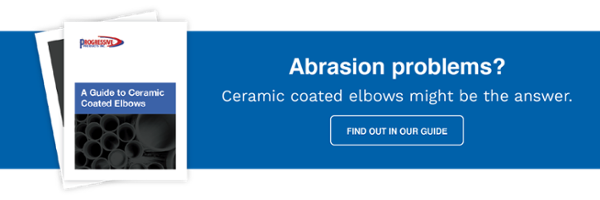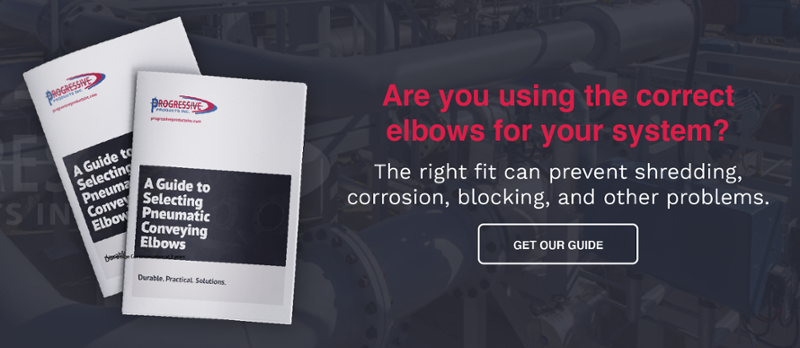If you handle grain, abrasive dust such as silica particles, pet food or powder chemical ingredients, the likelihood is that you will need wear resistant pipes and components in your pneumatic conveying system to combat wear and abrasion.
The Factors of Wear and Abrasion
The longevity of your conveying equipment directly depends upon the abrasion-resistance of your pipes, tubes, and related components. Wear is a natural process in most industrial machinery but it can be more pronounced if the following factors are involved:
- Extreme velocity
- Impact
- Friction or abrasion
How You can Minimize Maintenance Costs
You can minimize the need for frequent maintenance, regularly replacing various components, and reduce expense if your pneumatic conveying system uses components that are right for your needs. For instance, if you’re conveying a highly abrasive product, using ceramic lined pipes helps ensure that your system will perform efficiently and have a longer life expectancy.
If your pipes and elbows are stronger and more durable, your system will last longer while reducing costs and minimizing the headache of system downtime. A slowdown in production because of extensive repairs and component replacements can be largely avoided.
What is Ceramic Coating?
Ceramic coating is a ceramic layer that protects your system’s elbows and fittings at their weakest point. It can be placed internally, in which case it is called ceramic lining, or externally on ceramic-wrapped elbows.
A coating of ceramic on a pipe or elbow protects against abrasion and the impact of high-velocity particles flowing through a pneumatic conveying system.
What’s the Difference Between Ceramic Coating, Ceramic Wrapping, and Ceramic Lining?
The terms coating, wrapping, and lining are almost synonymous and are sometimes used interchangeably, but there are differences:
- Ceramic coating is an internal or external application of a ceramic layer
- Ceramic wrapping or backing is an external protective layer that serves as pressure reinforcement
- Ceramic lining is an internal protective layer
How Ceramic Coating Improves Elbows in a Pneumatic Conveying System
A ceramic coating reinforces your elbows, making them more resilient to abrasion, wear, and impact while maintaining pressure or vacuum.
A pneumatic conveying system can easily become damaged if your pipes, elbows, and other components aren’t fit for the purpose. Your system must be resilient to the forces of wear and tear.
The forces of impact, abrasion, and frictional heat are greatest in the elbows because of the change in direction of conveyed material.
Benefits of Ceramic Coating
Ceramic wrapping or lining pneumatic conveying elbows helps to:
- Resist extreme abrasion
- Prevent damage
- Increase the life of your elbow by around 8X to 50X
- Can make your elbows stronger through reinforcement
Ceramic on the Mohs Hardness Scale
The Mohs scale measures how hard different substances are by testing their resistance to being scratched by ten reference minerals. If one substance can be scratched by another substance but not the other way around, the second substance is harder. The ten reference minerals on the Mohs scale are:
- Talc - 1
- Gypsum - 2
- Calcite - 3
- Fluorite - 4
- Apatite - 5
- Orthoclase - 6
- Quartz - 7
- Topaz - 8
- Corundum - 9
- Diamond - 10
“Hardness” is defined as the capacity to withstand compressive and tensile stress. It is also defined in terms of abrasive resistance. Ceramic has a hardness score of 9+ on the Mohs scale - compare that to diamond, which has a hardness of 10, and you can start to understand why ceramic coating your elbows is so effective.
The Brinell Hardness Scale
The Brinell hardness scale is more applicable to metal and is conducted using an indentation test, while the Mohs scale is applicable to minerals using the scratch test.
There is no exact mathematical formula for converting the Mohs scale into the Brinell hardness scale. However, for example, mild steel is around 125 on the Brinell scale, whereas Ceramic is close to 2,000.
If you need help in selecting the right elbows for your pneumatic conveying system, it’s best to talk with an expert so you can ensure you get the correct components for your needs.
At Progressive Products, we won’t sell you anything you don’t need – contact us today to find the right solution for you.



